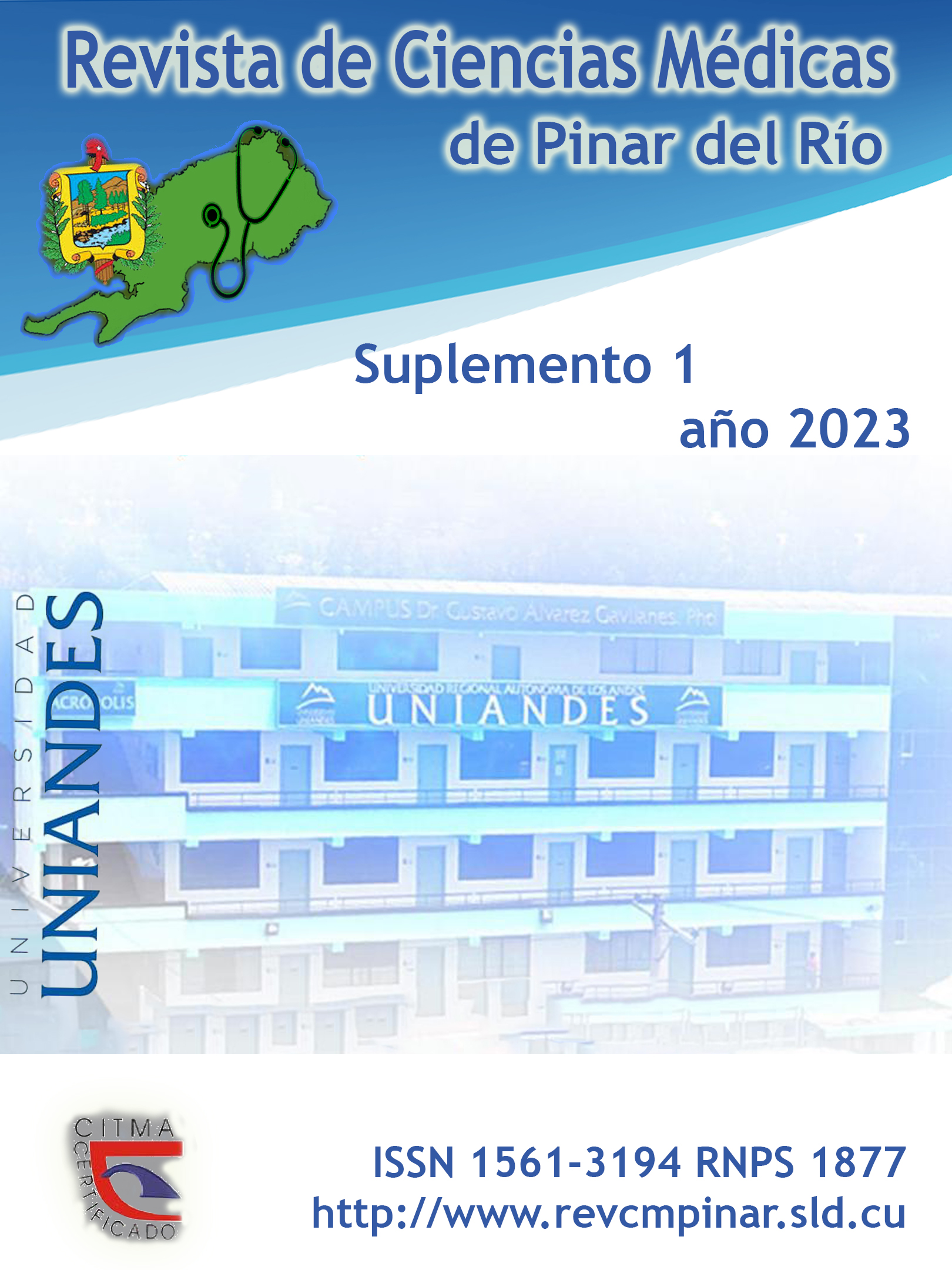Preventive techniques for adequate oral care in children from the Julio Moreno Espinosa school, Ecuador
Keywords:
ORAL HEALTH, PREVENTION, CARIES, TECHNIQUES.Abstract
Introduction: having good oral health is important from the first years of the child's life, this consists of having proper hygiene, periodic controls, adequate nutrition, not consuming sweets in excess, this will help to avoid oral problems in adolescence and adulthood.
Objective: to evaluate the level of knowledge of parents with children from three to five years old about oral hygiene and preventive techniques.
Methods: an observational, descriptive and cross-sectional study was carried out in parents with children from three to five years old on oral hygiene and preventive techniques, from September to November 2022. The universe consisted of 50 parents, the sample was made up of 39.
Results: It was obtained that 62 % of the parents know which are the adequate toothpastes for their children, 21 % do not know and 18 % do not know much about the subject. 95 % of parents recognize that it is important to visit the dentist periodically and 5 % do not believe it is necessary at such an early age. It was found that 74 % of parents supervise brushing their children three times a day, 3 % do not do it and 23 % do it sometimes.
Conclusions: educating children towards good oral health is essential to prevent cavities and other diseases. With the proper guidance, they will progressively adopt habits and behaviors aimed at health as part of their daily routine.
Downloads
References
1. Section On Oral Health. Maintaining and improving the oral health of young children. Pediatrics [Internet]. 2014 Dec [citado 28/11/2022]; 134(6):1224-9. Disponible en: https://pubmed.ncbi.nlm.nih.gov/25422016/
2. Inocente-Díaz ME, Pachas-Barrionuevo F de M. Educación para la Salud en Odontología. Rev Estomat Herediana [Internet]. 2012 [citado 27/11/2022]; 22(4): 232-41. Disponible en: https://revistas.upch.edu.pe/index.php/REH/article/view/91
3. Saavedra NB. Educación para la conservación de la salud bucal. Rev Odont Mex [Internet]. 2020 [citado 27/11/2022]; 24(4):228-32. Disponible en: https://www.medigraphic.com/cgi-bin/new/resumen.cgi?IDARTICULO=101874
4. Zou J. [Oral health management for children]. Hua Xi Kou Qiang Yi Xue Za Zhi [Internet]. 2018 oct [citado 28/11/2022]; 36(5):465-8. Disponible en: https://pubmed.ncbi.nlm.nih.gov/30465336/
5. Consecuencias del mal cuidado bucodental y cómo evitarlas [Consejos] [Internet]. Odontomecum Blog; 2018 [citado 11/11/2022]. Disponible en: https://www.dvd-dental.com/blogodontomecum/consecuencias-mal-cuidado-bucodental/
6. Lebrun-Harris LA, Canto MT, Vodicka P, Mann MY, Kinsman SB. Oral Health Among Children and Youth With Special Health Care Needs. Pediatrics [Internet]. 2021 Aug [citado 28/11/2022]; 148(2): e2020025700. Disponible en: https://pubmed.ncbi.nlm.nih.gov/34290133/
7. Ghandour RM, Hirai AH, Kenney MK. Children and Youth With Special Health Care Needs: A Profile. Pediatrics [Internet]. 2022 jun [citado 28/11/2022]; 149(Suppl 7): e2021056150D. Disponible en: https://pubmed.ncbi.nlm.nih.gov/35642877/
8. Kenney MK, Chanlongbutra A, Fanflick PL, Ferrero A, Kim S, Novoa C. Systems of care among children and youth with special health care needs with and without adverse childhood events: National Survey of Children’s Health 2016-2017. Disabil Health J [Internet]. 2022 Apr [citado 28/11/2022];15(2):101226. Disponible en: https://pubmed.ncbi.nlm.nih.gov/34772650/
9. Okunseri C, Gonzalez C, Hodgson B. Children’s Oral Health Assessment, Prevention, and Treatment. Pediatr Clin North Am [Internet]. 2015 Oct [citado 28/11/2022]; 62(5):1215-26. Disponible en: https://pubmed.ncbi.nlm.nih.gov/26318948/
10. Kagihara LE, Niederhauser VP, Stark M. Assessment, management, and prevention of early childhood caries. J Am Acad Nurse Pract [Internet]. 2009 Jan [citado 27/11/2022]; 21(1):1-10. Disponible en: https://pubmed.ncbi.nlm.nih.gov/19125889/
11. Yost J, Li Y. Promoting oral health from birth through childhood: prevention of early childhood caries. MCN Am J Matern Child Nurs [Internet]. 2008 [citado 28/11/2022]; 33(1):17-23; quiz 24-5. Disponible en: https://pubmed.ncbi.nlm.nih.gov/18158522/
12. Menguez Becerra T, Sexto Delgado N, González Beriau Y. Programa educativo sobre salud bucal para madres con niños en edad preescolar. MEDISUR. [Internet] 2009 [Citado 28/11/2022]; 7(1) Disponible en: https://www.redalyc.org/pdf/1800/180020302006.pdf
13. Higiene oral para niños: Empezar pronto y bien, todo Papás. [Internet]. Actualizado 2020 [citado 28/11/2022]; pág. 1-3. Disponible en: http://www.todopapas.com/ninos/cuidadosinfantil/higiene
14. Campos L, Rabaldo Bottan E, Bez Birolo J, Garcia da Silveira E, Eger Schmitt BH. Conhecimento de mães de diferentes classes sociais sobre saúde bucal no município de Cocaldo Sul (SC). RSBO Rev Sul-Bras Odontol. [Internet]. 2010 [citado 28/11/2022]; 7(3):287-95. Disponible en: https://www.redalyc.org/articulo.oa?id=153017325007
Downloads
Published
How to Cite
Issue
Section
License
Authors who have publications with this journal agree to the following terms: Authors will retain their copyrights and grant the journal the right of first publication of their work, which will be publication of their work, which will be simultaneously subject to the Creative Commons Attribution License (CC-BY-NC 4.0) that allows third parties to share the work as long as its author and first publication in this journal are indicated.
Authors may adopt other non-exclusive license agreements for distribution of the published version of the work (e.g.: deposit it in an institutional telematic archive or publish it in a volume). Likewise, and according to the recommendations of the Medical Sciences Editorial (ECIMED), authors must declare in each article their contribution according to the CRediT taxonomy (contributor roles). This taxonomy includes 14 roles, which can be used to represent the tasks typically performed by contributors in scientific academic production. It should be consulted in monograph) whenever initial publication in this journal is indicated. Authors are allowed and encouraged to disseminate their work through the Internet (e.g., in institutional telematic archives or on their web page) before and during the submission process, which may produce interesting exchanges and increase citations of the published work. (See The effect of open access). https://casrai.org/credit/



